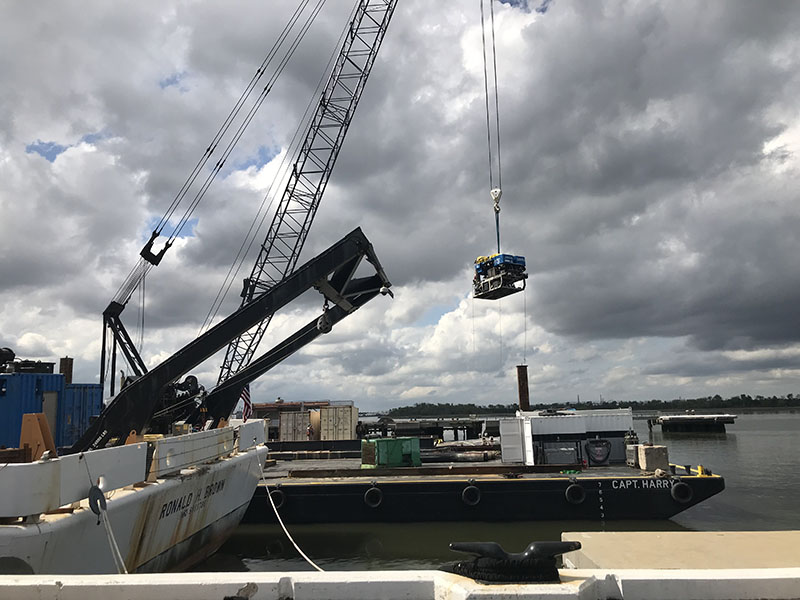
By Caitlin Adams, Web Coordinator, NOAA Office of Ocean Exploration and Research

NOAA Ship Ronald H. Brown docked at its home port at Pier PAPA at the Federal Law Enforcement Training Center in Charleston, South Carolina. Image courtesy of DEEP SEARCH 2019 - BOEM, USGS, NOAA. Download larger version (jpg, 4.2 MB).
Just after 1:30pm today, NOAA Ship Ronald H. Brown pulled away from the dock in Charleston, South Carolina, for the official start of DEEP SEARCH 2019! Departure came after four full days of mobilization, or “mobe” as it’s more commonly called. Mobe days give the science and remotely operated vehicle (ROV) teams the time they need to ensure that all their gear—and it’s a LOT of gear—makes it from the dock to the ship’s deck and is properly up and running before departure.
For the ROV Jason team, mobe began extra early: all 201,700 pounds (that’s the equivalent of about 20 African elephants!) of their equipment had been shipped to a nearby pier, where it was loaded onto a barge and tugged alongside NOAA Ship Ron Brown last Friday, April 5. A barge-based crane was then used to pick all the Jason equipment off of the barge and place it in the right spots on the back deck. The entire evolution had to be carefully planned in advance by the ROV team and the ship’s crew—once a 44,000 pound winch is loaded, there’s no moving it. To ensure everyone was on the same page, the Jason team developed a deck plan layout indicating where all major equipment (ROV; winch; hydraulic crane; and four 20-foot shipping containers that function as the control, tool, and storage vans) would be placed, which both the science team and ship reviewed.

This barge (back) and barge crane (front) were used to load all large equipment for the ROV Jason and DEEP SEARCH science teams. By the time this photo was taken, much of the equipment had already been transferred to the Ron Brown and only a couple of vans (far right) remain on the barge. Image courtesy of DEEP SEARCH 2019 - BOEM, USGS, NOAA. Download larger version (jpg, 6.2 MB).
ROV Jason is by no means the only equipment to arrive on the aft deck for DEEP SEARCH, though. Between Friday and today, the ship’s crane loaded a multicore, a benthic lander, hundreds of pounds of weights for the lander, a refrigerator, a chest freezer, and numerous pallets of scientific gear for the 10 principal investigators that make up this year’s DEEP SEARCH science team. The barge crane also loaded an isotope lab van onto the forward deck. The van, which is funded by the National Science Foundation and managed by Oregon State University, functions as a portable, safe, “plug-and-play” laboratory space where the Joye lab can complete their radiotracer experiments.

The ship’s crane was used to pick up the Royal Netherlands Institute for Sea Research’s (NIOZ) benthic lander from the dock. The lander will later be deployed onto the seafloor, where its specialized instruments will collect long-term environmental data. Image courtesy of DEEP SEARCH 2019 - BOEM, USGS, NOAA. Download larger version (jpg, 4.5 MB).
While all that heavy lifting was happening, the science team was busy assembling, storing, and securing all their gear in the ship’s lab spaces. The Ron Brown is actually one of three sister ships to the R/V Atlantis, so many of our space setups are similar to last summer’s expedition. Before getting underway, it’s crucial that everything is in some way secured to the ship (via bungee cords, ratchet straps, non-skid liner, etc.), so that we don’t wake up tomorrow morning to any broken or loose equipment.

ROV Jason is carried by the barge crane to its position on the port side of the aft deck. Image courtesy of DEEP SEARCH 2019 - BOEM, USGS, NOAA. Download larger version (jpg, 3.7 MB).
As we head out to sea this evening, we know we might be heading into rough weather for the next few days. Offshore forecasts can be variable though, especially when you’re dealing with an unpredictable environment like the Gulf Stream current. For now, we’ll head toward our first station, Hoyt Hills, and see exactly what the weather is doing when we arrive. We’ve got a backup plan for our backup plan, to make certain that we have some sort of work to do when we get there!